Asian vegetable production is rapidly expanding in Florida because these minor crops are often more profitable than traditional vegetable crops such as potatoes. As a result, the acreage of Asian vegetable crops is increasing; there are more than 7,000 acres (A) in the state today. Luffa is one of these popular crops. Young fruits are edible and have high nutritional and medicinal values (Partap et al. 2012; Azeez, Bello, and Adedeji 2013). The mature fruit is strongly fibrous and can be used to make bath or dish sponge scrubbers (Siqueira, Bras, and Dufresne 2010; Sivakandhan et al. 2020). There are two luffa species grown in Florida: smooth luffa (Luffa aegyptiaca Mill.), primarily for gardens, and angled luffa (Luffa acutangula (L.) Roxb.), for commercial production. (See EDIS publication #HS1285 for more information.) However, no UF/IFAS fertilizer recommendation is available for growers to follow. The symptoms of nitrogen (N) deficiency and iron (Fe) deficiency look similar, and therefore confusing, in luffa plants. To help Extension agents and growers diagnose nutrient deficiency in luffa, we present the symptoms of nitrogen (N) and iron (Fe) deficiencies and explain their differences. The audience for this publication includes Extension agents, certified crop advisors, crop consultants, environmentalists, policymakers for agriculture, and students interested in crop production.
Nitrogen
Sufficient Range
The sufficient range of nitrogen in luffa leaf tissue is 3.5% to 6.0% (35,000 to 60,000 ppm) N on a dry weight basis (Mills and Jones 1996). Plants in this range have healthy green foliage and grow vigorously. However, if too much N fertilizer is applied, leaf tissue N can exceed 6.0%, causing excessive vegetative growth. This excess growth can produce deficiencies of other nutrient elements due to dilution effects and ultimately lower fruit yields if these complementary nutrients are not sufficiently supplied. Furthermore, any unabsorbed N would remain in the soil and lead to weed pressure or fertilizer runoff. The best strategy is to reduce N fertilizer rather than add other nutrient elements, since added costs would likely reduce farm-gate income.
Deficiency
All forms of nitrogen are mobile in luffa plants. When N is in short supply, N in luffa plants will be withdrawn from older leaves and transported to younger leaves or other plant tissues. Thus, N deficiency symptoms first appear on older leaves. Typical symptoms include slow or stunted growth and weak plant structure; the plant will likely produce smaller leaves with yellow or light-green color and necrosis in a severe shortage of N (Figures 1 through 5). Figure 1 shows that the plant grown hydroponically without N supply for two weeks was only 7” in height, whereas the plant supplied with sufficient N grew 63” tall. Yield and quality of luffa were significantly reduced without sufficient N supply. Luffa plants suffering from severe N deficiency cannot complete their life cycle and cannot yield any fruit.
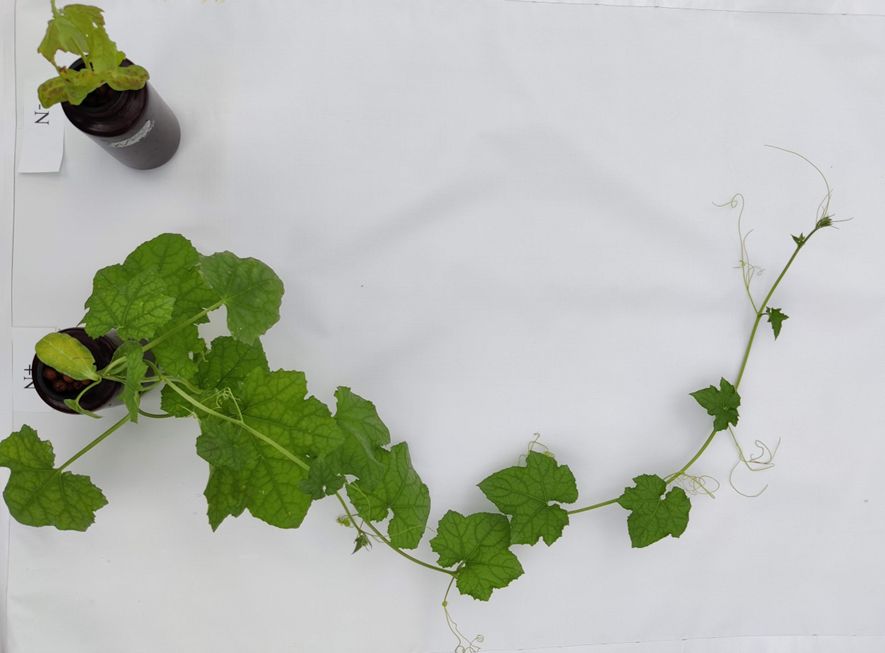
Credit: Qiansheng Li, UF/IFAS
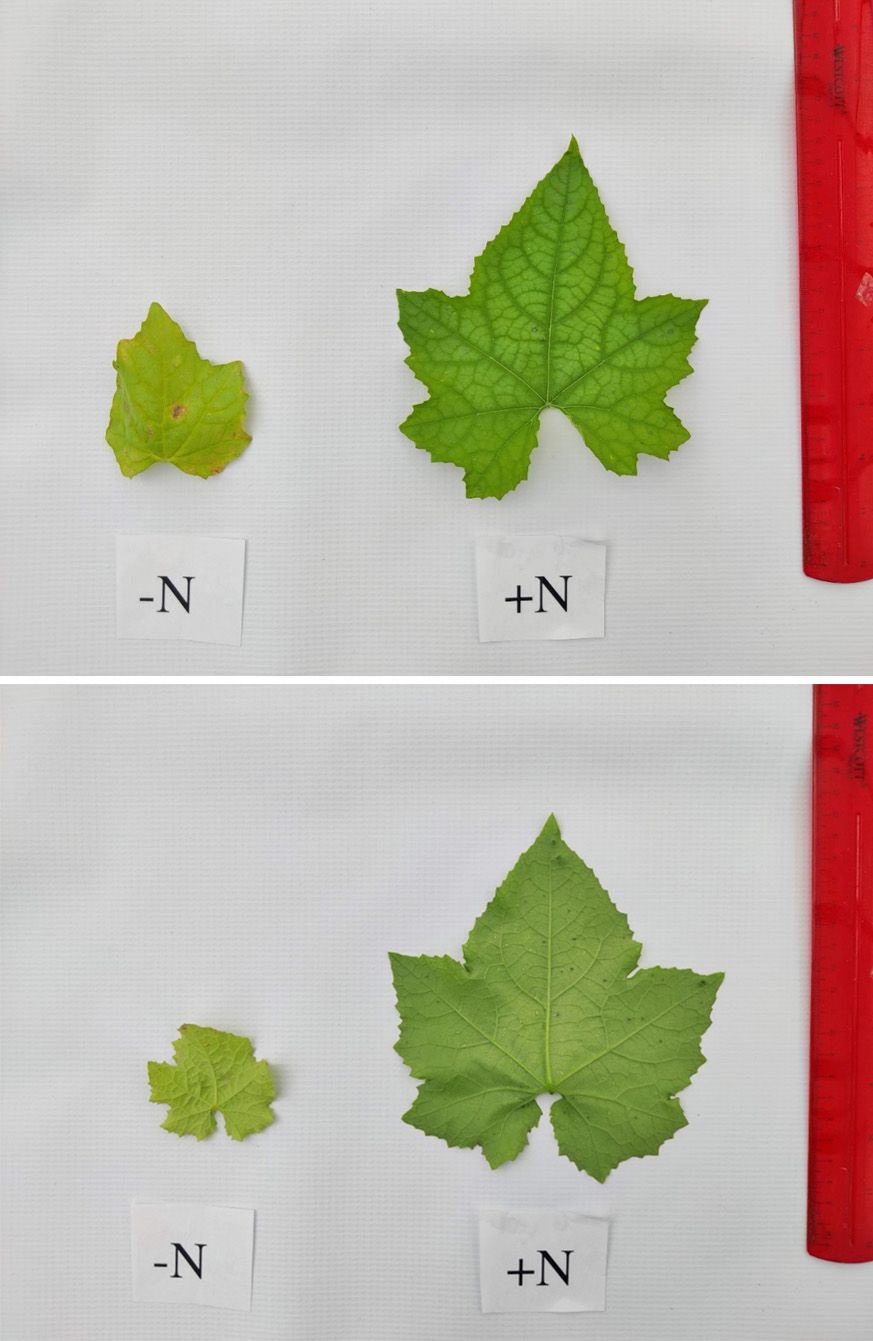
Credit: Qiansheng Li, UF/IFAS
Fertilizer Application
There is no current UF/IFAS N fertilizer recommendation available for luffa, but research is ongoing. Luffa and cucumber belong to the same family (Cucurbitaceae). Therefore, luffa growers can use the recommendation for cucumber, 150 lb/A (acre) of N, until luffa research justifies a change.
If dry granular N fertilizer is used, then four split applications are recommended: 20 lb/A preplant (0 to 2 days before planting), 30 lb/A 3 to 4 weeks after planting, 50 lb/A at first blooming, and 40 lb/A at first harvest. If fertigation is implemented, N fertilizers can be split into 15 lb/A preplant, 10 lb/A/week from 15 to 49 days after planting, 15 lb/A/week from 50 to 70 days after planting, and 10 lb/A/week from 71 to 98 days after planting (Table 1).
Table 1. Dry granular fertilization and fertigation for luffa production in Florida.
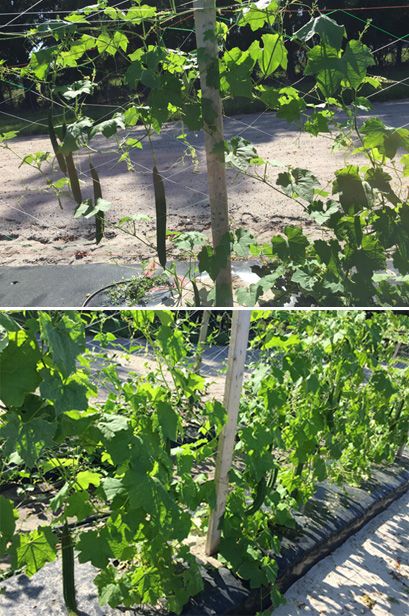
Credit: Yanlin Wang, UF/IFAS
Iron
Sufficient Range
The sufficient range of iron in Cucurbita leaves is usually between 0.005% to 0.035% (50 to 350 ppm) Fe on a dry weight basis (Barker and Pilbeam 2015). However, in Florida, leaves normally contain 0.003% to 0.015% (30 to 150 ppm) Fe on a dry weight basis. The optimum concentration should range from 40 ppm to 100 ppm (Hochmuth and Hanlon 2022). Fe deficiency is frequently a nutritional problem in Florida vegetable crops (Ozores-Hampton 2013). Conversely, Fe toxicity is rarely reported. Excess Fe supplementation, however, not only raises production costs but also causes phosphorus fixation.
Deficiency
Iron is immobile within the plant; therefore, symptoms initially occur on newly developed leaves (Korcak 1987). Chlorosis (yellowing of green leaves due to a lack of chlorophyll) on new leaves is the typical symptom of Fe deficiency, with interveinal chlorosis and green veins occurring on young leaves in the early stage of deficiency (Korcak 1987). Shoot tips, or growing points, and the newly developed leaves always show the Fe symptoms and are the most severely affected plant tissues (Figures 4 and 5) if plants suffer from Fe deficiency. When Fe deficiency is severe, older leaves can also display chlorosis, while the main veins remain green (Figure 6). This characteristic can be used to distinguish Fe deficiency from N deficiency. The latter displays chlorosis on mature, and older leaves because N is mobile in plant.
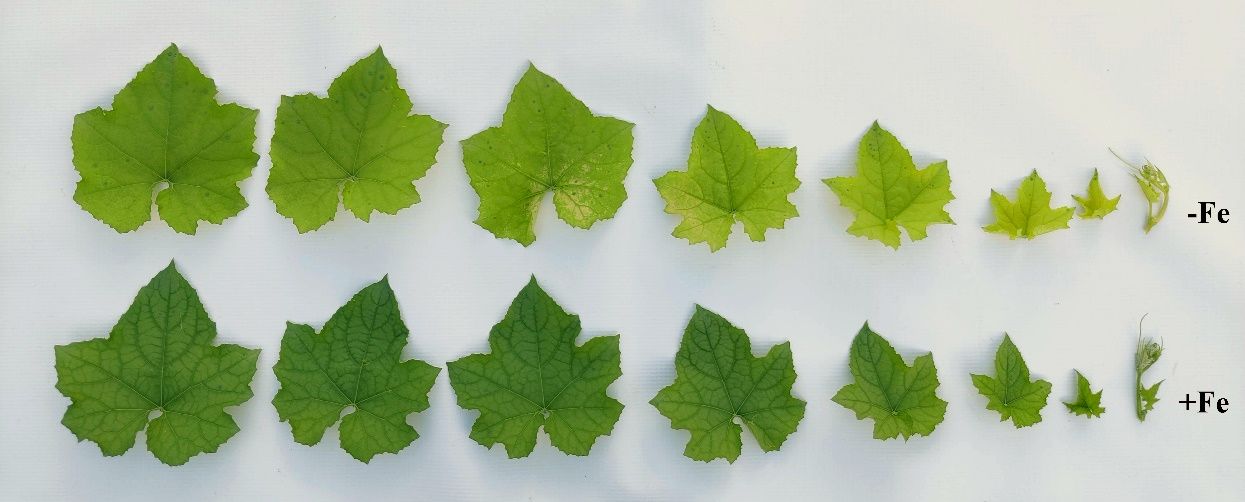
Credit: Qiansheng Li, UF/IFAS

Credit: Qiansheng Li, UF/IFAS
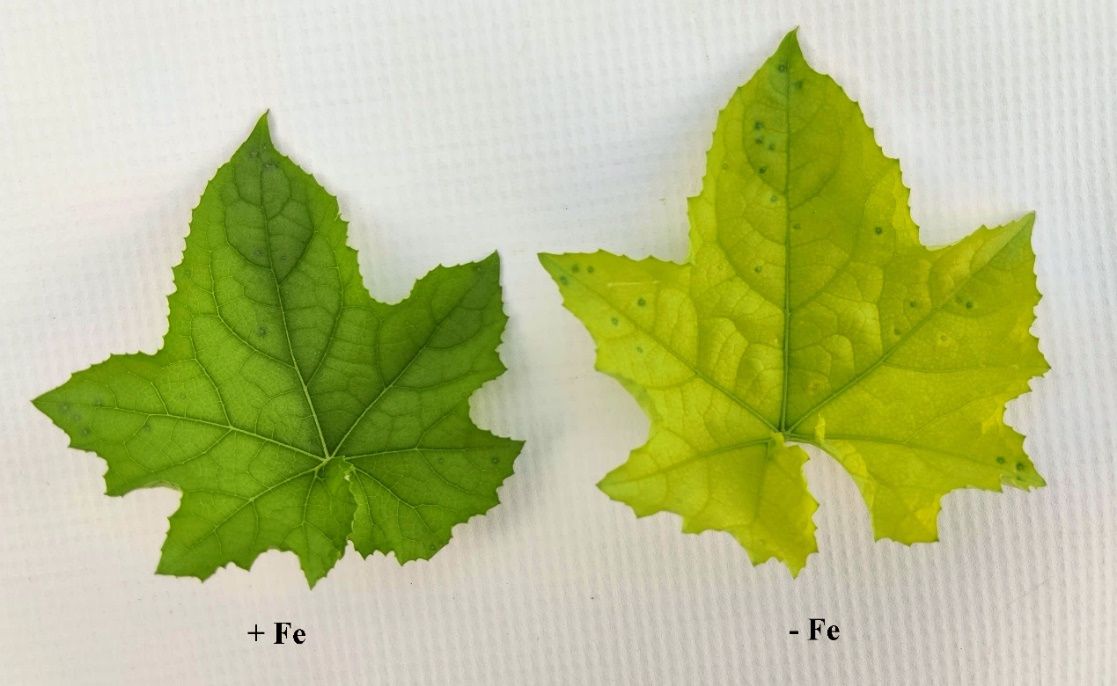
Credit: Qiansheng Li, UF/IFAS
Causes and Corrections
Iron deficiency occurs mostly in calcareous, poorly drained, and compacted soils. The soil Fe available to plants decreases as the soil pH increases, similarly to copper, manganese, zinc, and phosphorus in soil (Korcak 1987; Barker and Pilbeam 2015; Mondal, Mondal, and Mondal 2020). It is important to diagnose the deficiency by monitoring symptoms at the early stage and to take correct measures to prevent yield loss.
Iron fertilization through soil application is inefficient due to the rapid oxidization of ferrous iron (Fe2+) to its ferric form (Fe3+) as precipitation occurs in soil with high pH (Barker and Pilbeam 2015; Mondal, Mondal, and Mondal 2020). Foliar spray of ferrous sulphate solution or chelated iron at 0.2% is the fastest and most efficient approach to correct such deficiency (Barker and Pilbeam 2015; Mondal, Mondal, and Mondal et al. 2020). Chelated iron is an alternative foliar spray, more effective than ferrous sulfate. Be aware that FeEDTA is a chelated iron suitable for use in acidic soils due to its instability in high pH conditions, whereas others like FeDTPA or FeEDDHA are better suited for alkaline soils (Barker and Pilbeam 2015). Iron-containing fertilizers may also be applied directly to soils at 0.5–2 lb/A.
References
Ananda Murthy, H. C., A. K. Nair, M. Anjanappa, D. Kalaivanan, S. Shankara Hebbar, and R. H. Laxman. 2020. “Effect of NPK Fertigation on Post-harvest Soil Nutrient Status, Nutrient Uptake and Yield of Hybrid Ridge Gourd [Luffa acutangula (L.) Roxb] Arka Vikram.” International Journal of Chemical Studies. 8(4): 3064–3069. https://doi.org/10.22271/chemi.2020.v8.i4ak.10117
Ananda Murthy, H. C., A. K. Nair, M. Anjanappa, D. Kalaivanan, S. Shankara Hebbar, and R. H. Laxman. 2020. “Growth and Fruit Yield of Hybrid Ridge Gourd [Luffa acutangula L. Roxb] Arka Vikram in Relation to NPK Fertigation.” International Journal of Chemical Studies. 9(6): 3954–3963. https://doi.org/10.20546/ijcmas.2020.906.464
Azeez, M. A., O. S. Bello, and A. O. Adedeji. 2013. “Traditional and Medicinal Uses of Luffa cylindrica: A Review.” Journal of Medicinal Plants Studies. 1(5): 102–111.
Barker, A. V., and D. J. Pilbeam. 2015. In Handbook of Plant Nutrition, 2nd edition, edited by A. V. Barker and D. J. Pilbeam. Boca Raton, FL: CRC Press. https://doi.org/10.1201/b18458
Hochmuth, G. J., and E. Hanlon. 2022. Plant Tissue Analysis and Interpretation for Vegetable Crops in Florida. HS964. Gainesville: University of Florida Institute of Food and Agricultural Sciences. Accessed on August 18, 2023. https://edis.ifas.ufl.edu/publication/EP081
Korcak, R. 1987. "Iron Deficiency Chlorosis." In Horticultural Reviews, edited by J. Janick. 9: 133–186. https://doi.org/10.1002/9781118060827.ch5
Mills, H. A., and J. B. Jones, Jr. 1996. Plant Analysis Handbook II. Athens, GA: Micro-Macro Publishing.
Mondal, B., C. K. Mondal, and P. Mondal. 2020. “Abiotic Stresses: Nutritional and Physiological Disorders.” In Stresses of Cucurbits: Current Status and Management. Singapore: Springer Singapore. 239–256. https://doi.org/10.1007/978-981-15-7891-5_5
Ozores-Hampton, M. 2013. "Effective Strategies to Correct Iron Deficiency in Florida Vegetable Crops." HortTechnology. 23(5): 548–552. https://doi.org/10.21273/HORTTECH.23.5.548
Partap, S., A. Kumar, N. K. Sharma, and K. Jha. 2012. "Luffa cylindrica: An Important Medicinal Plant." Journal of Natural Product and Plant Resources. 2(1): 127–134.
Siqueira, G., J. Bras, and A. Dufresne. 2010. "Luffa cylindrica as a Lignocellulosic Source of Fiber, Microfibrillated Cellulose, and Cellulose Nanocrystals." BioResources. 5(2): 727–740. https://doi.org/10.15376/biores.5.2.727-740
Sivakandhan, C., R. Balaji, G. B. Loganathan, D. Madan, and G. Murali. 2020. "Investigation of Mechanical Behavior on Sponge/Ridge Gourd (Luffa aegyptiaca) Natural Fiber Using epoxy and Polyester Resin." Materials Today: Proceedings. 22(3): 705–714. https://doi.org/10.1016/j.matpr.2019.09.183
Wang, Y., G. Maltais-Landry, B. Rathinasabapathi, S. A. Sargent, and G. Liu. 2021. “Growth and Yield Responses of Pot-Grown Long Bean and Luffa to Nitrogen Rates.” Agriculture. 11(11): 1145–1155. https://doi.org/10.3390/agriculture11111145
Xie, Y., G. Liu, Y. Li, and K. Migliaccio. 2023. Luffa—An Asian Vegetable Emerging in Florida. HS1285. Gainesville: University of Florida Institute of Food and Agricultural Sciences. https://edis.ifas.ufl.edu/publication/HS1285